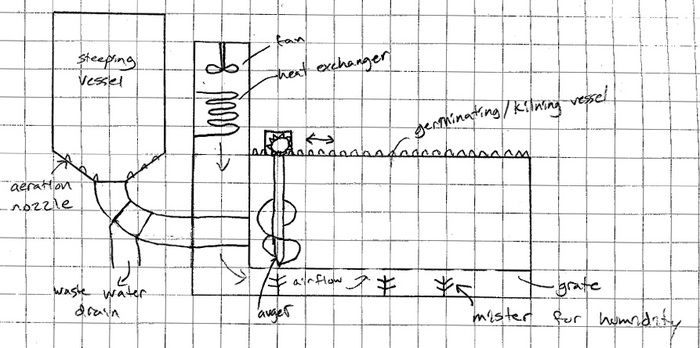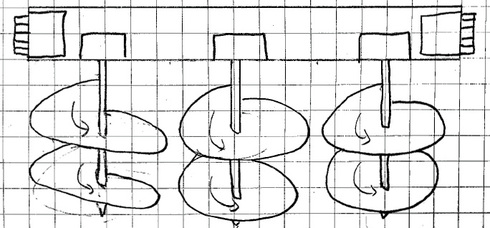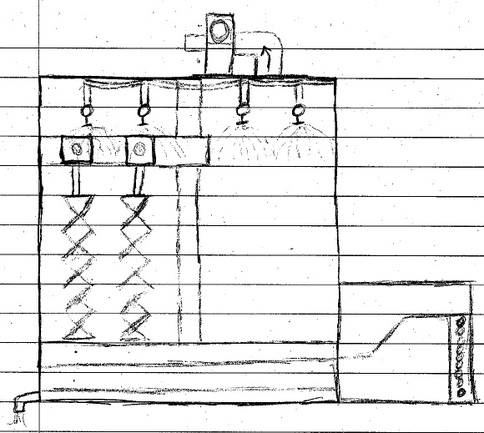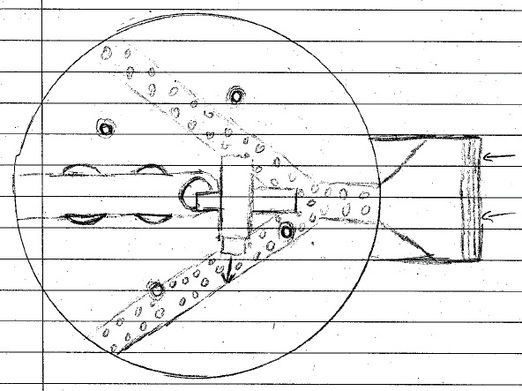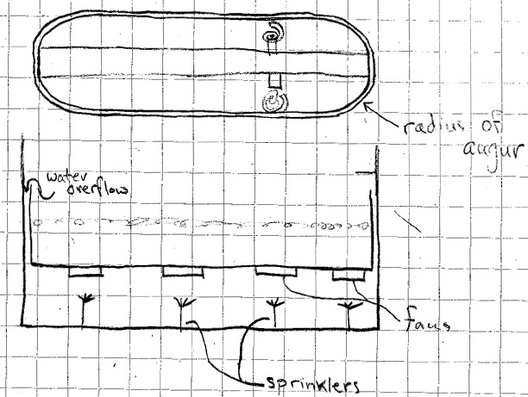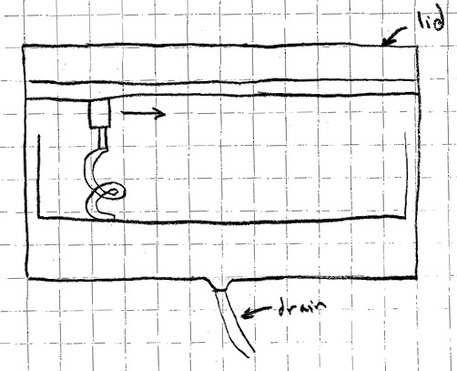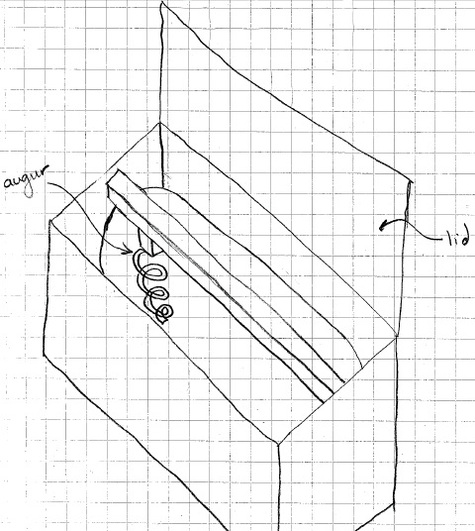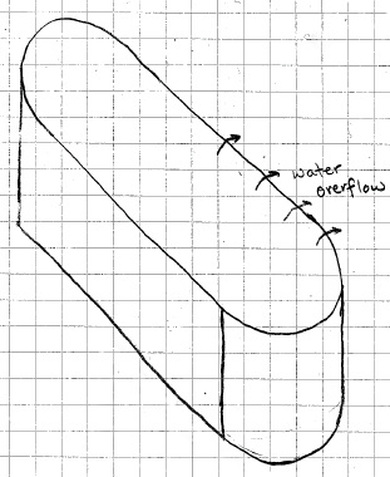| aarons_design_proposal.pdf |
| aarons_design_proposal2.pdf |
Design Proposal 1
One design to consider is having a malter that performs the steeping phase in a separate vessel. This vessel could be any shape or size, as long as it is large enough to handle the appropriate amount of barley. The barley would be allowed to steep and couch in this separate, waterproof section. Aeration nozzles would be required to keep the water full of oxygen to allow the barley to breathe during this first stage of the malting process. A system for removing CO2 buildup would need to by installed if the vessel were to have a lid. Due to the small batch size in this malter it would be just as acceptable to have an open steeping chamber. This would allow the CO2 to diffuse out of the vessel on its own. The barley could be washed in this separate vessel as well. An overflow drain near the top of the vessel will allow the dirt and chaff to be flushed out of the barley. Load Cells would be needed in the steeping vessel to measure the weight of the batch. This would allow the operators to track the moisture gain of the barley. When the grain had absorbed enough water to begin the germination phase it would be moved to the germination and kilning vessel (GKV). The simplest way to do this would be to have the steeping vessel above the GKV. It would be a simple matter to open a valve at the bottom of the first vessel and flush the grain down into the GKV. Augers that run along a track on the outside of the GKV would spread the grain evenly throughout bed. The same augers would also be responsible for turning/mixing the barley to prevent matting during germination and allow for even drying during kilning. Fans will push air through the GKV. This air will allow for healthy respiration during germination. Using a heat exchanger, the same air can be heated to dry the grain during the kilning phase. A set of sprinklers or misters above the GKV will enable the vessel to cope with the heat produced during germination, as well as keep the air humid. Lastly, one section of the wall will open on hinges to allow for quick and easy unloading of the finished malt.
Pros
Cons
Pros
- Do not have to make one vessel compatible with all three processes.
- Simple design
- Industry standard
Cons
- More material required (expensive)
- Larger, less portable
- Requires moving the grain from one vessel to another
| curtis_design_proposal.pdf |
Design Proposal 2
The second design we looked at was a circular type, which is similar to the Schmidt-Seeger pilot malting system described in section 2.1.2. The main difference is the ability to also kiln in our proposed design. Kilning is accomplished by using a heat exchanger in which hot water under high pressure flows through to heat incoming air. The heat exchanger is seen in in the above pictures to the right of the circular malting chamber. After the air passes through the heat exchanger it then flows into two ~4" diameter pipes arranged in a Y formation. The pipes are drilled with many holes to allow a more even distribution of airflow through the grain. Above the pipes is a false bottom with a mesh size large enough to allow adequate airflow, yet small enough to keep barley from passing through. The hot air flows through the barley and is finally sucked out the top of the malter by a high pressure blower. This same air flow path is used during germination, but without the heat exchanger on.
Steeping is accomplished by 4+ sprinklers hanging from the top of the malter. As designed the the malter would be free draining and so would not immerse the barley in water, but be wetted by the sprinklers. The sprinklers would also serve to keep the temperatures down and the humidity high during germination.
Finally mixing is accomplished by two augers which rotate around a shaft in the center of the malter. This circular design would allow for the barley to travel around the chamber. If the airflow and water penetration through the grain bed were not uniform this travel would help mix the grain to attain a uniform product. Also the lack of corners would prevent grain from getting stuck and receiving too much/too little airflow or water.
Pros
Cons
Steeping is accomplished by 4+ sprinklers hanging from the top of the malter. As designed the the malter would be free draining and so would not immerse the barley in water, but be wetted by the sprinklers. The sprinklers would also serve to keep the temperatures down and the humidity high during germination.
Finally mixing is accomplished by two augers which rotate around a shaft in the center of the malter. This circular design would allow for the barley to travel around the chamber. If the airflow and water penetration through the grain bed were not uniform this travel would help mix the grain to attain a uniform product. Also the lack of corners would prevent grain from getting stuck and receiving too much/too little airflow or water.
Pros
- Creates a very uniform malted barley
- Easy to clean because of lack of corners
- Sprinklers a cheap, yet foolproof way to keep germinating grain cool and humid
Cons
- Circular design may be expensive to manufacture
- Malter would be larger and less portable
- Lack of immersion during steeping wouldn't allow even water adsorption
| tylers_design_proposal.pdf |
| tylers_design_proposal2.pdf |
Design Proposal 3
The rectangular shaped single-chambered malter is one design that we are considering. I have designed this malter to have rounded edges so the augurs can mix all of the barley and not have to get into any corners. The round edges will have the same radius as the augurs. The pictures above shows a rough sketch of the rectangular malter. The chamber that contains the barley will be inside an outer casing. The outer casing will house the sprinklers, fans, and overflow system. I have also placed sprinklers under the barley chamber to humidify the air. There are also fans at the bottom of the barley chamber that will aerate the barley during the germination and kilning phases. The overflow system will wash the barley. We will fill up the barley chamber with water during the steeping phase and when the chamber is full the water will flow over the edges. We will direct the overflow water to the drain. There will be two circular augurs that will mix the barley during germination and kilning. The augurs will travel linearly throughout the chamber.
Pros
Cons
Pros
- Cheaper and easier to manufacture
- Overflow system will result in consistent water absorption
- Not as bulky
Cons
- Airflow will not be as efficient
- May be hard to control the cooling during germination
